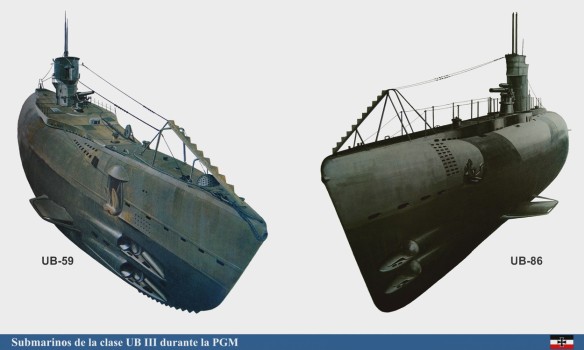The Type UB III represents the pinnacle in the design of German attack submarines during the First World War, and this project was undoubtedly one of the best in the world, and during many years. After the war, some of these vessels served until 1935 with the Allied navies. Thirty-seven units had been lost during the conflict and the rest had been surrendered to the Allies following the Armistice of November 1918. As we can see in the illustration, the numerous units in this class shared a common layout while having many differences in the details.
The Type UB III began to be deployed in the mid 1917, when United States declared war on Germany. When the Allied merchant fleet started to be organized in escorted convoys, it became more difficult to engage enemy shipping without being spotted by the escorting destroyers. Nevertheless, these submarines performed very well, sinking 507 merchant ships – for a total of 1,212,553 gross register tonnes – and twelve warships, including the pre-dreadnought battleship HMS Britannia in 1918.
After the war Germany had forbidden by the Treaty of Versailles to create a new submarine force. But German admirals had no intention of allowing their nation to forget the knowledge of building submarines, and Germany started to manufacture slightly modified versions of the Type UB III for exportation. Keeping the skills of German engineers polished by this means, eventually it was ordered the construction of a new coastal attack submarine based on the Type UB III, but including improvements such as an all-welded construction and a set of electronic and electromechanical devices. The result was the Type VII, the most common class of U-boat deployed by the Kriegsmarine during the Second World War.
British Coastal UB Wrecks
Launched on 26 June 1918, UB-130 was one of the last U-boats to enter the First World War. Initially passed to the French as part of the Armistice agreement, she was soon to returned to the UK for breaking and was under tow when she broke adrift and sank off Beachy Head in East Sussex. The wreck, said to be in three main parts, was subsequently located by divers, its identity being confirmed by the number UB-130 stamped on one of its propellers. In 2001, Roger Theobald and a team of divers from the British Su Aqua Club undertook the task of bringing the three-ton gun ashore. After cleaning and preservation, the gun was placed on display outside Newhaven Maritime Museum.
Built by A. G. Weser, the 55.3m UB-130 was commissioned in June 1918. She joined I Flotilla in October of that year but only had time to make one wartime patrol before the Armistice. Her commander is reputed to have been the grandly named Heinrich XXXVII Prinz zu Reuss.
Interestingly, the scattered remains of the Type UB-III submarine UB-121 can still be found at low water on the beach between Birling Gap and Cuckmere Haven, not far from where UB-130 was lost. On 14 April 1919 a French Navy tug, escorted by the destroyer Francis Garnier, ran into heavy weather off Beachy Head while towing two U-Boats from Harwich to Cherbourg. The towing hawser parted and the two boats, U-118 and UB-121, both of which had been allocated to France as war reparations, drifted towards the shore. UB-121 was not merely grounded, but was driven into the side of a South African steamship, Oushla, which had been stranded near Beachy Head since 6 November 1916. UB-121 was washed clear of the wreck on the following high tide, but she settled on the shore alongside.
Also built by A. G. Weser, at Bremen in 1918, UB-121 had a crew of thirty-four and a range of more than 9,000 miles. She was commanded by Oberleutnant zur See Albrecht Schmidt and, after working up, joined III Flotilla in May 1918. She carried out three war patrols but enjoyed no successes. Together with Oushla, UB-121 was partially demolished by a Welsh contractor in 1928. Further work was carried out in 1959. Despite that, small pieces remain, including a section of bow casing from immediately forward of the torpedo tubes, but it is sometimes difficult to distinguish between those bits that have come from UB-121 and those which came from the steamship.
Type UB III: 96 units (UB-48 to UB-133, UB-136, UB-142 to UB-145, UB-148 to UB-150, UB-154, UB-155)
Type: Attack submarine
Length: 55.30–57.80 meters
Beam: 5.76–5.80 meters
Draught: 3.67–3.85 meters
Displacement (surfaced): 508–555 tonnes
Displacement (submerged): 629–684 tonnes
Propulsion: 2 x shaft, 2 x Diesel engine 550 horsepower, 2 x electric motor 390 horsepower
Speed (surfaced): 13.2–13.9 knots (24.4-25.7 kilometers/hour)
Speed (submerged): 7.4-8 knots (13.7–14.8 kilometers/hour)
Range (surfaced): 7120–9090 nautical miles (13186-16834 kilometers) at 6 knots
Range (submerged): 50-55 nautical miles (92.6-101.9 kilometers) at 4 knots
Test depth: 50 meters
Complement: 34
Armament: 5 x 500-millimeter torpedo tube (4 at prow, 1 astern), 10 x torpedo, 1 x 88 or 105-millimeter deck cannon
